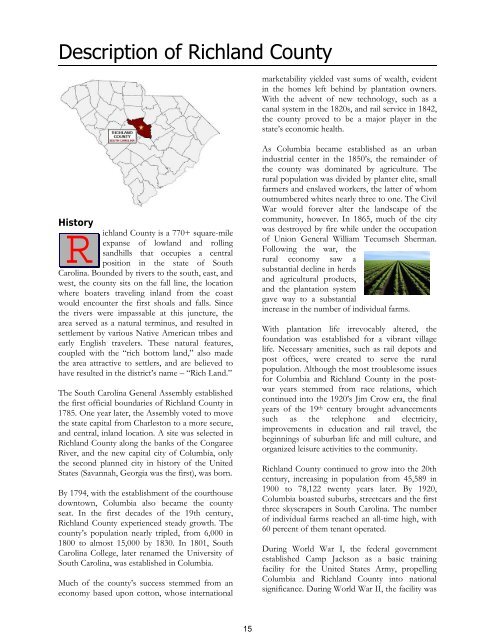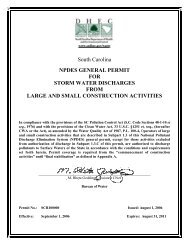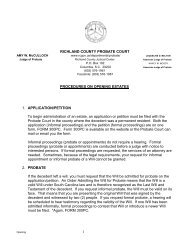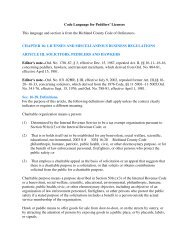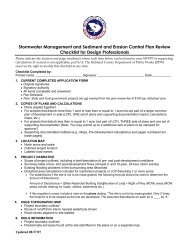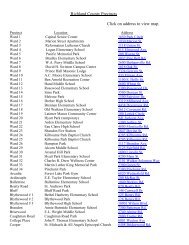- Page 2 and 3: Richland County GovernmentAnnual Op
- Page 4 and 5: Richland County GovernmentAnnual Op
- Page 7 and 8: Reader’s GuideThe purpose of this
- Page 9 and 10: Table of Contents Section TwoDetail
- Page 11 and 12: Table of Contents Section TwoDetail
- Page 13 and 14: Richland County GovernmentCounty Ad
- Page 15 and 16: Budget MessageThe total county adop
- Page 17 and 18: Budget MessageAgency FundingRevenue
- Page 19 and 20: Budget MessageMiscellaneous Revenue
- Page 21 and 22: Budget Message⇒ Uniforms and Equi
- Page 23 and 24: Budget MessageFY2010AdoptedFY2009Ad
- Page 25: Budget MessageFY2010AdoptedFY2009Ad
- Page 29 and 30: Description of Richland Countynumbe
- Page 31 and 32: Richland County - Form of Governmen
- Page 33 and 34: Budget Adoption ProcessPreparation
- Page 35 and 36: Budget Amendment ProceduresAfter th
- Page 37 and 38: Richland County Financial Policies
- Page 39 and 40: Richland County Financial Policieso
- Page 41 and 42: Richland County Financial Policiesa
- Page 43 and 44: Richland County Financial Policiesp
- Page 45 and 46: Richland County Financial PoliciesA
- Page 47 and 48: Budget SummaryAn overview of Richla
- Page 49 and 50: Budget Detail By FundThe Budget Det
- Page 51 and 52: Budget Detail By FundCounty FundsGo
- Page 53 and 54: Budget Detail By FundFire ServiceTh
- Page 55 and 56: Budget Detail By FundDebt Service F
- Page 57 and 58: Budget Detail By FundRiverbanks Zoo
- Page 59 and 60: Budget Detail By Fund2006 2007 2008
- Page 61 and 62: Summary of Estimated Financial Sour
- Page 63 and 64: Summary of Estimated Financial Sour
- Page 65 and 66: Major Revenue SourcesOne of the pri
- Page 67 and 68: Major Revenue SourcesFirst, the cou
- Page 69 and 70: Major Revenue SourcesBusiness Licen
- Page 71 and 72: Major Revenue SourcesThe county ear
- Page 73 and 74: Budget Staffing ComparisonThe graph
- Page 75 and 76: Fiscal Year 2010 Budget Estimation
- Page 77 and 78:
General FundThe general fund accoun
- Page 79 and 80:
General Fund Revenue (Source of Fun
- Page 81 and 82:
General Fund Expenditures (Use of F
- Page 83 and 84:
General Fund Summary by Expenditure
- Page 85 and 86:
General Fund Summary by Expenditure
- Page 87 and 88:
LegislativeThe Legislative Division
- Page 89 and 90:
Council ServicesOrganizational Char
- Page 91 and 92:
Legislative DelegationMission State
- Page 93 and 94:
Legislative Delegation2008 2009 201
- Page 95 and 96:
Master-In-EquityMission StatementTo
- Page 97 and 98:
Master-in-Equity2008 2009 2010Actua
- Page 99 and 100:
Probate CourtOrganizational ChartPr
- Page 101 and 102:
Magistrate CourtsMission StatementT
- Page 103 and 104:
Administrative Magistrate2008 2009
- Page 105 and 106:
Dentsville Magistrate2008 2009 2010
- Page 107 and 108:
Eastover Magistrate2008 2009 2010Ac
- Page 109 and 110:
Hopkins Magistrate2008 2009 2010Act
- Page 111 and 112:
Olympia Magistrate2008 2009 2010Act
- Page 113 and 114:
Upper Township Magistrate2008 2009
- Page 115 and 116:
SolicitorMission StatementTo effect
- Page 117 and 118:
Solicitor2008 2009 2010Actual Adopt
- Page 119 and 120:
Clerk of CourtState Judges Telephon
- Page 121 and 122:
Clerk of Court2008 2009 2010Actual
- Page 123 and 124:
County AdministratorMission Stateme
- Page 125 and 126:
County AdministratorOrganizational
- Page 127 and 128:
Department of Public Information200
- Page 129 and 130:
Ombudsman’s OfficeMission Stateme
- Page 131 and 132:
Ombudsman's Office2008 2009 2010Act
- Page 133 and 134:
County AttorneyFiscal Plan2008 2009
- Page 135 and 136:
ElectionsThe Elections Division is
- Page 137 and 138:
Board of Registration2008 2009 2010
- Page 139 and 140:
Election CommissionBudget Highlight
- Page 141 and 142:
TaxationThe Taxation Division is co
- Page 143 and 144:
AuditorFiscal Plan2008 2009 2010 Di
- Page 145 and 146:
TreasurerMission StatementTo collec
- Page 147 and 148:
Treasurer2008 2009 2010Actual Adopt
- Page 149 and 150:
Business Service CenterMission Stat
- Page 151 and 152:
Business Service Center2008 2009 20
- Page 153 and 154:
Assessment Appeals2008 2009 2010Act
- Page 155 and 156:
AssessorFiscal Plan2008 2009 2010 D
- Page 157 and 158:
Administrative and Staff ServicesTh
- Page 159 and 160:
FinanceBudget HighlightsFinanceFina
- Page 161 and 162:
ProcurementMission StatementWe shal
- Page 163 and 164:
Procurement2008 2009 2010Actual Ado
- Page 165 and 166:
Court Appointed Special AdvocatesBu
- Page 167 and 168:
Register of DeedsMission StatementT
- Page 169 and 170:
Register of DeedsOrganizational Cha
- Page 171 and 172:
Human ResourcesMission StatementTo
- Page 173 and 174:
Human Resources2008 2009 2010Actual
- Page 175 and 176:
Court AdministrationBudget Highligh
- Page 177 and 178:
Information TechnologyMission State
- Page 179 and 180:
Information Technology2008 2009 201
- Page 181 and 182:
Geographical Information Systems200
- Page 183 and 184:
Non-Departmental2008 2009 2010Actua
- Page 185 and 186:
Sheriff’s DepartmentMission State
- Page 187 and 188:
Sheriff’s DepartmentOrganizationa
- Page 189 and 190:
Sheriff's Department2008 2009 2010A
- Page 191 and 192:
Detention CenterMission StatementTo
- Page 193 and 194:
Detention CenterOrganizational Char
- Page 195 and 196:
Detention Center2008 2009 2010Actua
- Page 197 and 198:
Emergency Services DepartmentGoals
- Page 199 and 200:
Emergency Services DepartmentOrgani
- Page 201 and 202:
Emergency Medical Service2008 2009
- Page 203 and 204:
Planning and DevelopmentMission Sta
- Page 205 and 206:
Planning and Development ServicesOr
- Page 207 and 208:
Building Inspections2008 2009 2010A
- Page 209 and 210:
CoronerFiscal Plan2008 2009 2010Act
- Page 211 and 212:
Animal CareMission StatementTo prov
- Page 213 and 214:
Animal Care2008 2009 2010Actuals Ad
- Page 215 and 216:
Public Works AdministrationMission
- Page 217 and 218:
Public Works Administration2008 200
- Page 219 and 220:
Engineering DivisionFiscal Plan2008
- Page 221 and 222:
Support ServicesMission StatementTo
- Page 223 and 224:
Central ServicesMission StatementTo
- Page 225 and 226:
Central GarageMission StatementTo m
- Page 227 and 228:
Facilities and Grounds MaintenanceM
- Page 229 and 230:
Facilities & Grounds Maintenance200
- Page 231 and 232:
Facilities & Grounds - 2020 Hampton
- Page 233 and 234:
Facilities & Grounds - 1400 Huger S
- Page 235 and 236:
Facilities & Grounds - Sheriff Subs
- Page 237 and 238:
Facilities & Grounds - Two Notch Rd
- Page 239 and 240:
Facilities & Grounds - Eastover Mag
- Page 241 and 242:
Facilities & Grounds - Beatty Road2
- Page 243 and 244:
Health DepartmentMission StatementT
- Page 245 and 246:
Vector ControlMission StatementTo p
- Page 247 and 248:
Department of Social ServicesMissio
- Page 249 and 250:
Soil and Water ConservationMission
- Page 251 and 252:
Outside Agency Funding2008 2009 201
- Page 253 and 254:
Sources and Uses of Special Revenue
- Page 255 and 256:
Special Revenue Fund Budget Summary
- Page 257 and 258:
Special Revenue Summary by Expendit
- Page 259 and 260:
Victims Assistance ProgramDescripti
- Page 261 and 262:
Temporary Alcohol Permit FundDescri
- Page 263 and 264:
Fire Service FundDescriptionThe Fir
- Page 265 and 266:
Stormwater Service DivisionDescript
- Page 267 and 268:
Stormwater Service DivisionOrganiza
- Page 269 and 270:
Road Maintenance & Mass TransitBudg
- Page 271 and 272:
Accommodations TaxDescriptionThe Ac
- Page 273 and 274:
Hospitality TaxThe Chart below refl
- Page 275 and 276:
Neighborhood Redevelopment FundDesc
- Page 277 and 278:
Grants DivisionDescriptionRichland
- Page 279 and 280:
Enterprise FundsThe enterprise fund
- Page 281 and 282:
Enterprise Fund Budget SummaryThe e
- Page 283 and 284:
Enterprise Fund Summary by Expendit
- Page 285 and 286:
Solid Waste DivisionMission Stateme
- Page 287 and 288:
Solid Waste DivisionOrganizational
- Page 289 and 290:
Utilities and Services DivisionBudg
- Page 291 and 292:
Parking GarageDescriptionThis fund
- Page 293 and 294:
Capital Project FundsThe capital pr
- Page 295 and 296:
IntroductionLandCosts incurred by t
- Page 297 and 298:
Active ProjectsSummary of Funding S
- Page 299 and 300:
Active ProjectsProject Title: Fire
- Page 301 and 302:
Active ProjectsProject Title: Broad
- Page 303 and 304:
Active ProjectsProject Title: Renov
- Page 305 and 306:
Active ProjectsProject Title: Count
- Page 307 and 308:
Debt Service FundsThe debt service
- Page 309 and 310:
Debt ServiceDebt financing should n
- Page 311 and 312:
Outstanding DebtThe General Obligat
- Page 313 and 314:
Outstanding DebtGeneral Obligation
- Page 315 and 316:
Outstanding DebtSchool District One
- Page 317 and 318:
Outstanding DebtRecreation Commissi
- Page 319 and 320:
Debt Capacity (Statutory Limit)The
- Page 321 and 322:
Debt Service (annual obligations)Th
- Page 323 and 324:
Appendix A -Staffing Comparison & A
- Page 325 and 326:
Appendix A -General Fund Authorized
- Page 327 and 328:
Appendix A -General Fund Authorized
- Page 329 and 330:
Appendix A -General Fund Authorized
- Page 331 and 332:
Appendix A -General Fund Authorized
- Page 333 and 334:
Appendix A -General Fund Authorized
- Page 335 and 336:
Appendix A -General Fund Authorized
- Page 337 and 338:
Appendix A -General Fund Authorized
- Page 339 and 340:
Appendix A -General Fund Authorized
- Page 341 and 342:
Appendix A -Special Revenue Authori
- Page 343 and 344:
Appendix A -Enterprise Authorized P
- Page 345 and 346:
Appendix B - Budget OrdinanceMidlan
- Page 347 and 348:
Appendix B - Budget OrdinanceSECTIO
- Page 349 and 350:
Appendix C - Statistical SectionCom
- Page 351 and 352:
Appendix C - Statistical SectionSer
- Page 353 and 354:
Appendix C - Statistical Section% c
- Page 355 and 356:
Appendix D - Facility & Service Loc
- Page 357 and 358:
77^_46011767626321218^_1347^_Magist
- Page 359 and 360:
6017717632134976261762^_DISCLAIMER:
- Page 361 and 362:
32160177351^_1234567EMS Station1767
- Page 363 and 364:
Appendix E - GlossaryAccrual Basis
- Page 365 and 366:
Appendix E - GlossaryCapital Outlay
- Page 367 and 368:
Appendix E - GlossaryDeficit - The
- Page 369 and 370:
Appendix E - Glossaryis often used.
- Page 371 and 372:
Appendix E - GlossaryObject of Expe
- Page 373:
Appendix E - Glossaryrun as distinc


